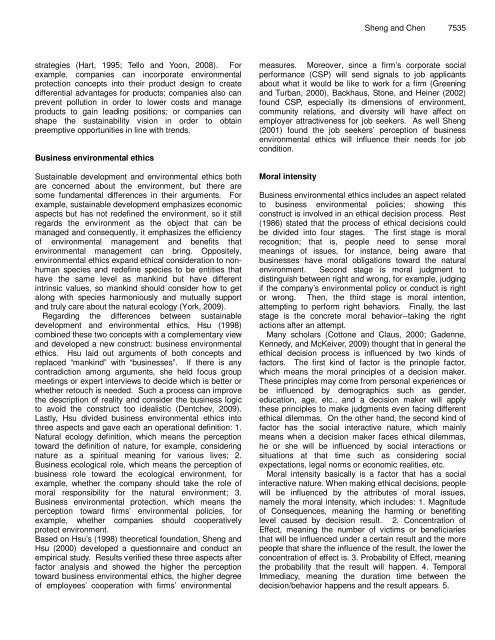Download Complete Issue (8760kb) - Academic Journals
Download Complete Issue (8760kb) - Academic Journals
Download Complete Issue (8760kb) - Academic Journals
Create successful ePaper yourself
Turn your PDF publications into a flip-book with our unique Google optimized e-Paper software.
strategies (Hart, 1995; Tello and Yoon, 2008). For<br />
example, companies can incorporate environmental<br />
protection concepts into their product design to create<br />
differential advantages for products; companies also can<br />
prevent pollution in order to lower costs and manage<br />
products to gain leading positions; or companies can<br />
shape the sustainability vision in order to obtain<br />
preemptive opportunities in line with trends.<br />
Business environmental ethics<br />
Sustainable development and environmental ethics both<br />
are concerned about the environment, but there are<br />
some fundamental differences in their arguments. For<br />
example, sustainable development emphasizes economic<br />
aspects but has not redefined the environment, so it still<br />
regards the environment as the object that can be<br />
managed and consequently, it emphasizes the efficiency<br />
of environmental management and benefits that<br />
environmental management can bring. Oppositely,<br />
environmental ethics expand ethical consideration to nonhuman<br />
species and redefine species to be entities that<br />
have the same level as mankind but have different<br />
intrinsic values, so mankind should consider how to get<br />
along with species harmoniously and mutually support<br />
and truly care about the natural ecology (York, 2009).<br />
Regarding the differences between sustainable<br />
development and environmental ethics, Hsu (1998)<br />
combined these two concepts with a complementary view<br />
and developed a new construct: business environmental<br />
ethics. Hsu laid out arguments of both concepts and<br />
replaced “mankind” with “businesses”. If there is any<br />
contradiction among arguments, she held focus group<br />
meetings or expert interviews to decide which is better or<br />
whether retouch is needed. Such a process can improve<br />
the description of reality and consider the business logic<br />
to avoid the construct too idealistic (Dentchev, 2009).<br />
Lastly, Hsu divided business environmental ethics into<br />
three aspects and gave each an operational definition: 1.<br />
Natural ecology definition, which means the perception<br />
toward the definition of nature, for example, considering<br />
nature as a spiritual meaning for various lives; 2.<br />
Business ecological role, which means the perception of<br />
business role toward the ecological environment, for<br />
example, whether the company should take the role of<br />
moral responsibility for the natural environment; 3.<br />
Business environmental protection, which means the<br />
perception toward firms’ environmental policies, for<br />
example, whether companies should cooperatively<br />
protect environment.<br />
Based on Hsu’s (1998) theoretical foundation, Sheng and<br />
Hsu (2000) developed a questionnaire and conduct an<br />
empirical study. Results verified these three aspects after<br />
factor analysis and showed the higher the perception<br />
toward business environmental ethics, the higher degree<br />
of employees’ cooperation with firms’ environmental<br />
Sheng and Chen 7535<br />
measures. Moreover, since a firm’s corporate social<br />
performance (CSP) will send signals to job applicants<br />
about what it would be like to work for a firm (Greening<br />
and Turban, 2000), Backhaus, Stone, and Heiner (2002)<br />
found CSP, especially its dimensions of environment,<br />
community relations, and diversity will have affect on<br />
employer attractiveness for job seekers. As well Sheng<br />
(2001) found the job seekers’ perception of business<br />
environmental ethics will influence their needs for job<br />
condition.<br />
Moral intensity<br />
Business environmental ethics includes an aspect related<br />
to business environmental policies; showing this<br />
construct is involved in an ethical decision process. Rest<br />
(1986) stated that the process of ethical decisions could<br />
be divided into four stages. The first stage is moral<br />
recognition; that is, people need to sense moral<br />
meanings of issues, for instance, being aware that<br />
businesses have moral obligations toward the natural<br />
environment. Second stage is moral judgment to<br />
distinguish between right and wrong, for example, judging<br />
if the company’s environmental policy or conduct is right<br />
or wrong. Then, the third stage is moral intention,<br />
attempting to perform right behaviors. Finally, the last<br />
stage is the concrete moral behavior--taking the right<br />
actions after an attempt.<br />
Many scholars (Cottone and Claus, 2000; Gadenne,<br />
Kennedy, and McKeiver, 2009) thought that in general the<br />
ethical decision process is influenced by two kinds of<br />
factors. The first kind of factor is the principle factor,<br />
which means the moral principles of a decision maker.<br />
These principles may come from personal experiences or<br />
be influenced by demographics such as gender,<br />
education, age, etc., and a decision maker will apply<br />
these principles to make judgments even facing different<br />
ethical dilemmas. On the other hand, the second kind of<br />
factor has the social interactive nature, which mainly<br />
means when a decision maker faces ethical dilemmas,<br />
he or she will be influenced by social interactions or<br />
situations at that time such as considering social<br />
expectations, legal norms or economic realities, etc.<br />
Moral intensity basically is a factor that has a social<br />
interactive nature. When making ethical decisions, people<br />
will be influenced by the attributes of moral issues,<br />
namely the moral intensity, which includes: 1. Magnitude<br />
of Consequences, meaning the harming or benefiting<br />
level caused by decision result. 2. Concentration of<br />
Effect, meaning the number of victims or beneficiaries<br />
that will be influenced under a certain result and the more<br />
people that share the influence of the result, the lower the<br />
concentration of effect is. 3. Probability of Effect, meaning<br />
the probability that the result will happen. 4. Temporal<br />
Immediacy, meaning the duration time between the<br />
decision/behavior happens and the result appears. 5.

















